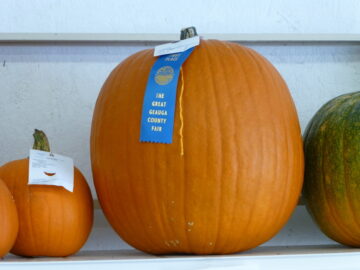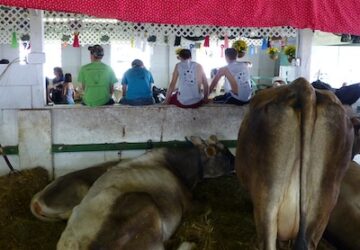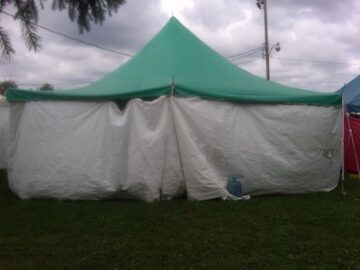by Steve Szilagyi
“Body and spirit are twins. God only knows which is which” –Algernon Swinburne

When I was ten or eleven, the Great Geauga County Fair still displayed what it called human oddities (the term Freak Show had fallen from use by that time). These included the Lizard Man, the Human Pincushion, and the Fat Lady. All were pictured in large paintings outside their tents. The Fat Lady’s picture might have come from the brush of Fernando Botero, the Colombian painter and sculptor who made a career out of depicting round and puffy men, women, and animals. But the real Fat Lady did not look like that at all.
“Ask me anything,” she said, as my brother and I stood before her, staring. An electric fan rippled the hem of her simple cotton dress in the late August heat. She must have been in her 30s, pink-cheeked, with massive calves. Her eyes stared past us, and her voice was flat.
My brother and I could think of nothing to ask. Even as ten and eleven-year-olds, we felt nothing but pity for this woman. She was not one of those people who are “big-boned” but a slight person who was carrying too much weight. There were romance magazines (so many!) piled at her feet, suggesting that she had a rich imaginative life.
We also felt kind of cheated. The Fat Lady was not a legitimate “other” like the Lizard Man, her neighbor in the tent next door. The Lizard Man had black, cracked skin, and stumps for arms and legs. He wore a porkpie hat, sunglasses, and satin shorts. “Hit the Road Jack” trilled from the transistor radio by his head. We thought he was cool. The Fat Lady might have been one of our country aunts if she’d eaten too many of her own apple and pumpkin pies.
The Lizard Man couldn’t help what he was. But all the Fat Lady had to do was lose some weight, and she’d be outside the tent with us—a regular person. Of course, it’s not that easy. We all know that the extent to which the obese are responsible for their condition is a topic of hot controversy.
We are all Boteros now. The Great Geauga County Fair (the “Great” is an official part of its name) is the oldest county fair in Ohio. The human oddities are long gone. But while the Fat Lady has disappeared, there are plenty of obese people visible in the crowds that throng the Fair’s midway, barns, and agricultural buildings. They haul their heavy selves along, sniffing the air, drawn deeper into the fair by the sights and smells arising from the scores of food tents, trucks, and sheds up ahead of them.
In today’s Fair crowd, the Fat Lady of the early 1960s would not stand out. Last year, I stood on the midway taking pictures, trying not to include any Amish (they don’t like getting their picture taken) or any obese individuals (so as not to embarrass them). It was easy enough to keep the Amish out of the frame. But it was almost impossible to exclude the big people. We are all Boteros now.
No irony here. The Great Geauga County Fair is one of the world’s great irony-free zones. The 4-H kids showing their cattle, the farm women competing for ribbons in the pie, cake, jam, and flower-arranging competitions, the dressage girls, VFW men, tractor fanciers, and horseshoe-throwing Amish are all in earnest. There is no pretend Americana or “Hee-Haw” hokeyness.

For all that the fair encourages the fatal habits of food addicts, no alcohol is allowed inside the gate. And although Geauga County is highly churched, there is no search for the transcendent here. The Fair is all about the physical—bodies, human and animal—moving them, feeding them, displaying them, and hurling them furiously around. Even the Fair’s long-favorite spectacles of tractor pulls and demolition derby are celebrations of bodies colliding or trying to pull away from one another.
Big John and Disney rash. Visitors are transported from their cars in the parking lots to the Fair entrance on enormous hay wagons. Once inside, they must walk a quarter mile down a midway filled with rides, carnival games, and the promotional tents of local businesses to get to where the food vendors are thickest. Many visitors can be seen struggling with their own weight long before they get there. They stop to catch their breath and mop the sweat from their brows.
I have often noticed that by this point, some of the strugglers had patches of red, inflamed skin that did not look like sunburn. Recently, I learned that this condition has a nickname: Disney rash. It’s exercise-induced vasculitis, so named because of its association with visitors to Disney parks who—aside from their annual trip to the Magic Kingdom—never get off the sofa. The shock of having to walk throws their skin and the systems that support it into confusion.
I worked in a hospital for 30 years in a non-medical capacity. In the late 1990s, the hospital saw that bariatric surgery was going to be the fastest-growing service line in the new century. They replaced the obstetrics unit with bariatric surgery rooms and beds with block-and-tackle lifts overhead. Chairs in waiting rooms and examination rooms hospital-wide were quietly replaced with broad, benchlike seating. Regular-sized restroom toilets were replaced with enormous basins on reinforced pedestals, whose seats were the size of old-fashioned horse collars (brand name: Big John).
In the 1990s, a visit from a 600-pound patient was something that was talked about. By the 2020s, you saw 900-pounders being wheeled around. One 900-pound patient I knew of had bariatric surgery, got down to a normal weight range, then gained it all back.
Whenever I come home from Costco and have to carry a 50-pound bag of cat litter from the car into my house, I think, “If I weighed 50 pounds more, it would be like carrying this thing around all day.”

Into the Swine Barn. Livestock barns take up a large portion of the Great Geauga County Fair’s 75 acres. Here, breeders of cattle, goats, pigs, sheep, and turkeys display their finest specimens, and some of the 4-H kids sleep side by side in the hay with the animals they’ve raised.
My brother and I enjoyed the Fair’s human oddities, thrill rides, and shooting galleries when we were kids. But the livestock barns are where we got an education. We found out, for instance, that farm animals are nothing like their stylized counterparts in children’s books. They are gross, grunting, and dripping ropes of saliva. We learned about the randiness of goats, the ugliness of turkey wattles, and why you don’t want to be standing behind a horse when it lifts its tail. We enjoyed the sheep and goat barns, poultry shed, and rabbit cages. But there was one barn we approached with a kind of solemn trepidation: the Swine Barn. The Swine Barn looked like the other barns at the fair. It was built of plain wooden planks, whitewashed, with large doors at either end. But there was something about it that was darker, almost gothic—beginning with the smell that struck you well before you entered its shadowed interior. You involuntarily held your breath before going inside.
The greatest of insults. The barn was filled with dozens of pens. But unlike the sheep and cattle barns, you didn’t see any animals at first. You had to go right over to the pens and look over the wooden slats. There, you’d see the swine, lying on their sides, frighteningly large and covered with sheets of flies. On my first visit to the Swine Barn, I recall understanding why it was that to call another person a “pig” was the greatest of insults. The size, the smell, and the grotesque ugliness of their mouths and prehensile snouts were appalling. And disturbingly, most had skin as pink and Caucasian as my own.
The pigs in the Swine Barn didn’t appear to be resting. They looked dead, like bodies in the Civil War photographs of Matthew Brady. They seemed to have collapsed under the weight of their own piggish bodies and had no ambition to rise again from their filthy straw beds. Their indolence was so total as to deflect any possible rebuke: “What do you expect from us? We’re pigs.”
Pigs have gotten slimmer. Today, the Swine Barn has enormous industrial fans at either entrance. The pens are cleaner, and if a 2020 article in The Guardian is to be believed, the pigs may be less fat. In an article titled “What a Porker! Why Pigs Have Gotten Slimmer and Humans Have Got Fatter,” a journalist has fun with the fact that modern taste for less-fatty meat has compelled swine breeders to develop leaner strains of pigs. So the average UK pig now has only 16% body fat, in contrast to the people of America, say, whose body fat averages 22-24% (men) and 35-40% (women).
I have no doubt that the 4-H kids who raise these pigs grow fond of them. “Babe” is one of my favorite movies. My mother raised a pig from infancy to maturity back in the 1940s. One day she came home from school to find it gone, and a few days later, was told that the bacon she’d eaten that morning was her own little “Chubs.” (One of the many tales she told to prepare her children for the cold-heartedness of the world.) As a lifelong vegetarian, I can look a pig in the eye with a good conscience. But I do not love them.
“Pig butchery” is a term that has arisen in the cyberworld to describe a common online scam. Internet pig butchers fatten you up through friendly online chats, the promise of romance, deceptive photographs, and casual mentions of their own personal wealth. Once the butchers have emotionally bonded with you, they persuade you to deposit money into phony investment accounts. Then—surprise—you’re tomorrow’s breakfast.
Real-life pig butchery is a billion-dollar business that processes tens of millions of tons of animals every year. The Chinese eat more pork than any people on earth, and there are videos online showing how thoroughly they have automated the killing and systematic butchery of pig bodies. You can see thousands of pink carcasses racing down disassembly lines being systematically sawn into uniform parts by one-after-another clever machine. It is an antiseptic spectacle far from the still, brooding animal carcasses painted by Rembrandt van Rijn, Claude Soutine, or Francis Bacon, or the grand immobility of the pigs in the Swine Barn at the Great Geauga County Fair.
Pigs, turkeys and black swans. The pigs in the Swine Barn do not brood. One of the piggish things about them is their spectacular complacency. They’re like the turkey described in Nicholas Taleb’s book, The Black Swan, who thinks that the farmer who feeds him every day is his friend … right up until Thanksgiving. The swine at the Great Geauga County Fair recline in their dreamy bulk, not knowing how close they are to the pneumatic hammer, the clashing knives, and busy saws.
Pigs are, of course, one of the most underestimated animals in terms of intelligence. They are said to be smarter than dogs and as smart as dolphins. Their cousins, the wild boars, are known for their ferocious activity—making themselves a threat to human life and property wherever they proliferate. Will these domestic pigs yield up anything like Swinburne’s spirit after their fatal meeting with the bolt pistol or stun gun? We can’t say for sure, but we can be fairly certain that they will yield up a generous freezer-full of pork jowls, chops, trotters, and fatback.
In the end, whether a pig can transcend its fate or whether it’s simply destined for the freezer remains a mystery. What is clear, however, is the troubling contrast between the pigs’ lack of awareness and the human condition—where body and spirit are intertwined, often to our detriment. Like Swinburne’s twins, perhaps the essence of our existence lies in this very confusion, where body and spirit live together like irascible conjoined twins – the freaks of the animal world.

